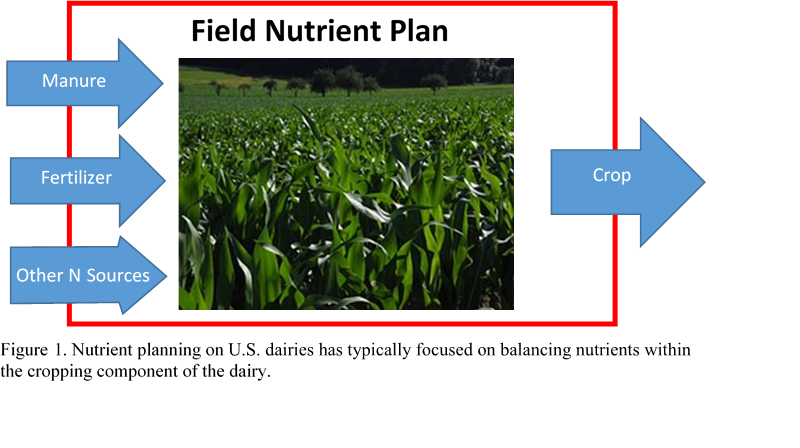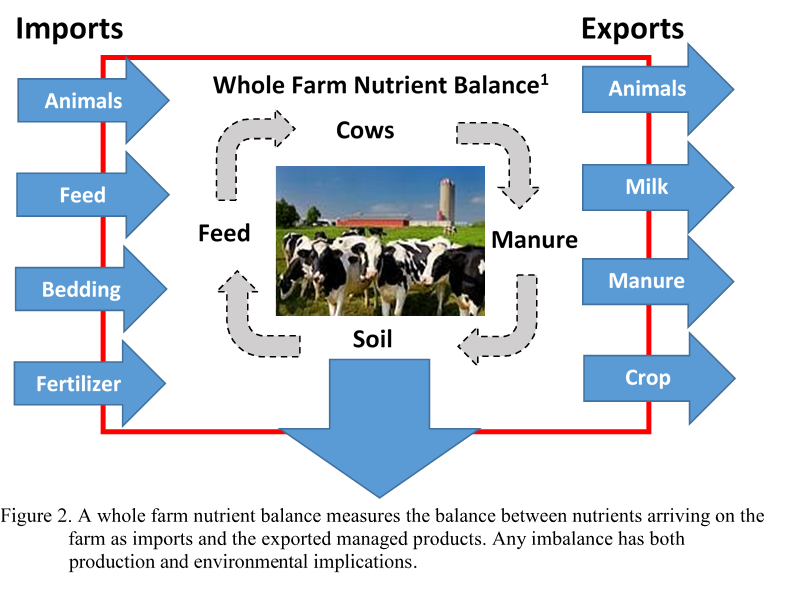Rick Koelsch
Professor, Biological Systems Engineering and Animal Science, University of Nebraska

Summary
Modern dairy farms are an increasing complex assembly of sub-systems for milk production, replacement herd development, and crop/feed production. The challenge of managing nutrients is complex both for those with integrated crop and dairy production as well as those focusing primarily on milk production alone. Quirine Kettering, faculty member at Cornell University’s Animal Science Department, and I conducted a review of nutrient balances observed by four studies on New York, Utah, and Idaho dairies to determine the ability of traditional nutrient management strategies, such as field based nutrient management plans, to effectively manage nutrients on dairy farms. This article is the first of a three-part summary of information shared at the Large Dairy Herd Management Conference held in Chicago in May 2-5, 2016. This first article will focus on the concept of “Whole Farm Nutrient Balance”.
Current Nutrient Strategies for Dairy Farms
Current public policy focuses management of nutrients within the cropping system. Nutrient management plans, are designed to balance cropping system nutrient inputs (manure, fertilizer and other nutrient credits) with the nutrients in the harvested crops (see Figure 1). This approach is used for nitrogen (N) and is the preferred approach for phosphorus (P).
As regulatory-based nutrient plans were first implemented in the early 2000’s, we learned that the quantity of P in manure was often beyond what could be managed within the cropping systems on many animal feeding

operations. Our focus changed to finding lower risk land application sites where excess P was allowed to accumulate. This excess P management strategy become known as the Phosphorus Index. The P Index procedure was intended to be a temporary approach for storing excess P during the transition to a more sustainable system. This transition has not always occurred.
Whole Farm Nutrient Balance
In some regions of the U.S. where livestock and crop farms continue to be a critical part of the nutrient loading within watersheds, other nutrient strategies such as Whole Farm Nutrient Balance (WFNB) are receiving renewed interest as a method of addressing the complexities of modern livestock systems. When nutrients are evaluated for the “whole farm” (see Figure 2), some important questions can be answered including:
- What nutrient purchase decisions (Imports) impact the farm’s environmental risk?

- Are there other opportunities for Exports of managed products (milk, crops, manure)?
- As nutrient management changes are made, is the dairy more sustainable?
WFNB is the difference between nutrients entering (Imported) and leaving as managed products (Exported). If an “Imbalance” between imports and managed exports exist, then a direct environmental loss (e.g. ammonia lost to the air or nitrates lost to surface or ground water) or a growing accumulation of nutrients on-farm (suggesting a growing environmental risk) results. WFNB is a comprehensive estimate of a dairy system’s environmental risk applicable to both dairies with and without an integrated cropping system.
Nutrients arrive on a dairy as purchased products (fertilizer, animal feed, and animals), nitrogen (N) fixed by legume crops, and nitrates in rain and irrigation water. These “Imports” are important to the production of milk and crops and also the origin of nutrients lost into the environment. Likewise, nutrients exit a livestock operation, preferably as managed products or “Exports” including animals, milk, crops, and manure exported to a neighboring farm.
The “Imbalance” between Imports and Exports can leave the farm as direct losses to the environment (e.g. nitrate lost to groundwater or ammonia released to the atmosphere). An Imbalance can also represent P accumulation in the soil or P in accumulating solids in a manure storage. Although not a direct loss to the environment, a growing accumulation of nutrients adds to the dairy’s environmental risk.
Within the boundaries of the farm, there is a “Recycling” of nutrients between the livestock and crop components. The efficiency of recycling these internal nutrients impacts the quantity of nutrients that are imported and exported. For example, efficient crediting of recycled manure nutrients reduces the commercial fertilizer imported and thus improves the overall WFNB.
WFNB is increasingly being considered as an alternative nutrient strategy for determining the environmental sustainability of an animal feeding operation. WFNB’s ability to evaluate the whole farm as opposed to one sub-system (cropping system), ability to measure a farm’s environmental risk, and capacity to identify more comprehensive solutions contributes to this interest.
The next newsletter will review common whole farm nutrient balances for dairy farms.